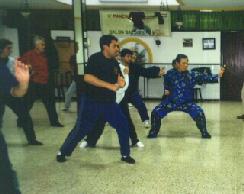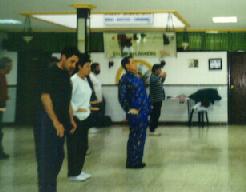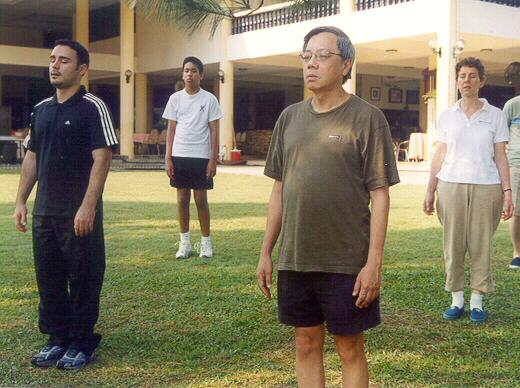August 2001 (Part 3)
SELECTION OF QUESTIONS AND ANSWERS


In the Shaolin Kungfu practised in Shaolin Wahnam Institute, it is not necessary to perform separate chi kung exercise because chi kung and kungfu are integrated. For example, after performing a kungfu set, Shaolin Wahnam disciples experience energy flow in a meditative state of mind, in a pattern called “Flowing Breeze Swaying Willow”.
Question 1
I have been training for 5 years in Choy-Li-Fatt externally and I have noticed injury after injury after injury. I have got to a stage where my body isn't coping too well with the extreme physical training and I have come to realize the true way Shaolin disciples used to train, using chi training to strengthen their bodies and increase their energy to be able to withstand extreme kung fu training.
— Scott, Australia
Answer
It is a basic tenet of Shaolin training that one should be healthy and fit first, only then train for combat efficiency. If a student is sick or weak, then he would practise Eighteen Lohan Hands (“Lohan Sap Pat Sau” in Chinese) or any other chi kung exercises to overcome his sickness first. As he continues his training he will become healthier and fitter.
Sustaining injury after injury, which surprisingly is not uncommon in many other martial art training today, is contradictory to the Shaolin teaching. One rarely gets hurt during sparring in Shaolin kungfu training. If a student is accidentally hurt, he is attended to immediately, and the injury is overcome before continuing with serious training.
Chi kung is an essential part of Shaolin Kungfu. In fact Shaolin Kungfu itself is chi kung. Every movement of Shaolin Kungfu training is a training of energy and mind. Besides strengthening the body, chi kung training provides the student with vitality so that he can better enjoy his daily work and play as well as purifies his spirit for his spiritual cultivation.
Question 2
I was given an option to attend Chi Gung classes at the start of my training and I did occasionally but never fully understanding why it was important, I always thought it was just a supernatural force of energy I could build up to break things and withstand attacks.
Answer
Different teachers have different ways of teaching kungfu and chi kung. In most schools, students learn separate chi kung exercises different from what they do in kungfu (including Taijiquan). In other words, they perform special chi kung exercises like Ba Duan Jin (Eight Pieces of Brocade) and Eighteen Lohan Hands, then they practise their normal kungfu.
In our school, Shaolin Wahnam, we do not perform separate chi kung exercises because it is already in the kungfu movements we do. For example, when we perform our kungfu patterns or practise sparring, we are doing chi kung. At the end of a short training session, like after practising “One Finger Shooting Zen”, for instance, we just let go and enjoy “flowing Zen” in a pattern called “Flowing Breeze Swaying Willow”.
We believe this was what was done in the Shaolin Temple in the past. Because we are doing “chi kung” at the same time we do “kungfu”, at the end of a vigorous 4-hour session, not only we are not tired, we are actually more fresh and energized than before the training.
“Flowing Breeze Swaying Willow” is “Yew Foong Pai Lau” in Chinese (Cantonese). Some classical kungfu texts mentioned that this was a very important pattern in Shaolin Kungfu, but very few people know what this pattern look like because it was never illustrated. There was no illustration for the pattern although it was very important simply because it did not have a fixed form.. It refers to countless forms resulting from spontaneous energy flow in a standing position.
Question 3
I was taught Five Animals and Eighteen Lohan, just the movements to start with. I am practising the Five Animals properly today with proper knowledge. In the last 6 months I have brought myself to going back to basics in kung fu. I have realised my posture is incorrect and I am using all the wrong muscles to move. So basically I am learning to walk all over again and to combat my weakness I am learning Eighteen Lohan from scratch and with correct posture
Answer
I am glad that you realize your mistakes and are determined to correct them. Correct posture is very important, in kungfu as well as in our daily life.
But what you probably do not realize is that merely correcting posture is not practising chi kung. If you just work on your posture, or on any physical forms, you are merely performing physical exercise.
To practise chi kung you have to work on your energy. And one can work on energy using any forms, not necessarily the Five Animal Forms and the Eighteen Lohan Hands. You can, for example, work on your energy using the ordinary kungfu forms you practise.
What is working on energy? Semantically, it is like asking what is eating an apple. If you have eaten an apple, or worked on energy, you would know it. If you wish to work on energy — which is another way of saying to practise chi kung — you have to learn from someone who knows how to work on energy. If you learn from someone who practises the Five Animal Forms or the Eighteen Lohan Hands, or any other chi kung exercise, as physical exercise, you will only be performing physical exercise.

“LIfting Water” is an excellent form of Taiji qigong
Question 4
Now this is where I am getting either confused or scared. Our system of Lohan comes from the Chan family of Choy-Li-Fatt. I have learnt the whole of the first form Sap Pat Lohan Sau, and have not even thought of learning Siu Lohan, Tai Lohan and Wu Chi at all.
I am basically playing dumb to the aspects of Sap Par Lohan Sau that are deeper, not thinking of anything, not trying to direct chi or visualizing anything inside me. I have basically been doing the movements so far with just an awareness of what each movement is doing inside me. This is where I am scared. I don't want pian cha in anyway. That is why I have been playing dumb to the visualizing of chi.
Answer
This is a very common problem many people face. They realize that something is missing in their kungfu or chi kung training — something that forms the essence of the art. There are three main approaches to follow.
Those taking the first approach read all they can about the essence of kungfu or chi kung. In today's age of mass information, they may obtain the information quite readily. Then they attempt the advanced exercises, like directing chi or visualization, which masters have warned them not to without proper supervision. This group is most unwise. Some from this group even teach others. They are not only unwise but also unethical.
Those following the second approach are prudent. They heed the masters' warning that incorrect training, which is likely without proper supervision, would lead to “pian char” or deviation, causing far-reaching side effects. They continue to practise their art at a physical level. They are safe but their progress is slow and little, and they are often disappointed that their achievements are so far from ideal. You belong to this group.
Those following the third approach realize that if they want the ideal benefits they have to learn from masters who themselves have these benefits. They search for the masters, whom may not be easy to find. But they are willing to pay the price — in terms of time and effort besides fees. They are the wise.
Question 5
Is there any harm practising this first form of Lohan. I don't have the exact knowledge of visualization or a sufficient instructor to guide me, although I know the later forms can be very dangerous and are told not to learn without a certified Chan family member or equivalent.
Answer
Anything when practised wrongly brings harm. The more powerful the form or art is, the more harm it can bring when practised wrongly.
Question 6
I am just worried that I am going to do more harm than good in this Lohan chi gung. I don't know if it is dangerous or not, but I really do want to continue on my long slow progress to become fully sufficient in this system.
Answer
If you grope about on your own in this Lohan Chi Kung, you are likely to get more harm than good. If you learn from a master or at least from a competent instructor, you are very safe.
If you wish to have something, be it a place in a prestigious university or a good kungfu system, you have to pay its price. Just as you cannot expect to enter a prestigious university if you do not score top marks — the university requirement, you cannot expect to be proficient in your art if you do not learn from a master — the art's requirement.
Question 7
I have not consulted my sifu about his yet, so I don't know his opinion or knowledge. Can you please give me some advise honourable master about the dangers of the Lohan systems if any.
Answer
You should consult your sifu.
If you perform the Lohan Hands as physical exercise, wrong training may result in tiredness and torn muscles, which may be overcome with rest.
If you perform them as chi kung or energy exercise, wrong training may result in distorted energy network in your body, which can lead to far-reaching and sometimes serious troubles, such as hormonal imbalance, emotional disorders and organic mal-function.
Question 8
Why do you charge US1000 when other masters are charging less?
— Ricky, USA
Answer
There are many reasons why I charge US$1000 per person for my Intensive Chi Kung Course when many other masters are charging much less for their chi kung classes, but it is sufficient here to give just one reason.
Most chi kung practitioners, including some chi kung masters, take more than 10 years to achieve an internal energy flow. This is no slight on the practitioners. I myself took more than 10 years to achieve this wonderful skill. But I enable my students to generate their own internal energy flow on the very first day of the Intensive Chi Kung Course!
Generating an internal energy flow is the essence of all chi kung. Once you can do this, you have the means to overcome any illness or to prevent any illness if you are already healthy. You can also use your internal energy flow to increase vitality and develop internal force.
It is understandable for some people to ask, “How do I know I can generate internal energy flow?”. This indicates they do not know how to do it. No one who has taken my course asks the question, because all the students know through direct experience. In other words, once you can generate an internal flow, you know you can do it, in the same way that once you can drive a car you won't ask, “How do I know I can drive a car?”
What would happen if after the course a student still does not know whether he can generate an internal energy flow? Then he does not have to pay the US$1000.

Why does Sifu Wong charge US$1000 for an Intensive Chi Kung Course when other masters charge less?
Question 9
You mentioned that there is a version of long distance running from Shaolin Kunggfu which is a qigong called “Art of Thousand Steps”. Would it be possible for you to elaborate on how this art was trained? It is naïve to hope to learn from a description, as such my reason for asking is that I wish to satisfy my curiosity about this art, which does not seem to be martial oriented. Is this qinggong?
— Wesley, Singapore
Answer
“The Art of Thousand Steps” is a basic qigong (chi kung) training to enable Shaolin students to run for some distance without feeling tired or out of breath. It is also a form of qinggong, or the art of lightness.
Some Westerners, used to rigid scientific definition, may ask whether it is qigong or qinggong.. The answer is that it can be called qigong, and also can be called qinggong. Chinese terms are often used provisionally, in the same way that a male human about 15 years can be called a boy or a young man.
The basic principle in “the Art of Thousand Steps” is that as the practitioner uses energy in his running, he not only takes in fresh supply of energy in time but also regulates its consumption efficiency as well as stores some for reserve. He usually uses Abdominal Breathing or Small Universe Breathing, and irrespective of the pace of his running, the pace of his breathing remains the same.
Herein lies the secret of “the Art of Thousand Steps”. As their pace of activity increases, untrained people become short of breaths because their breathing could not cope up with the increased energy demand. But trained practitioners do not have this problem because they have sufficient energy supply even when they maintain their normal breathing.
Regulating our breath when performing a kungfu set fulfils similar functions. Once we can regulate our breath to run a thousand steps, we can do so for any number of steps. Once we can regulate our breath for performing a kungfu set, we can do so for any other activities. Hence, our students in Shaolin Wahnam Institute could engage in a few hours of kungfu training, including vigorous sparring, without being short of breaths.
Question 10
Is there any general guideline I can follow to safely improve my long distance running using conventional running style of just stretching before, running and stretching after? Perhaps doing the qigong I learn from taijiquan after running to help repair any damage done?
Answer
Attempting to improve your long distance running by stretching before and after the run, is different from performing the Art of Thousand Steps. One is doing physical exercise as it involves stretching your muscles; the other is doing energy exercise, or qigong, as it involves managing energy.
It is this failure to understand the crucial difference between physical exercise and energy exercise that leads many people to think that learn qigong from books or videos by imitating its external movements.
Question 11
Perhaps doing the qigong I learn from taijiquan after running helps repair any damage done.
Answer
Yes, Taiji qigong or any qigong can repair the damage due to running or other vigorous physical exercise. The important point is whether you perform Taiji qigong, or merely perform its external forms which is actually performing physical exercise.
It is likely that you practise the external forms of Taiji qigong rather than Taiji qigong itself. In the same way, that is what most people do when they say they practise Taijiquan. What they actually practise are the external forms of Taijiquan, and not genuine Taijiquan itself. Had they practised genuine Taijiquan, they would be practising qigong and combat application, and not merely the external forms per se.
I conclude that you practise the external forms of Taiji gigong as gentle physical exercise, instead of genuine Taiji gigong itself, because had you done so you would not have thought of using your Taiji gigong to repair the damage done in running. You would not have any damage because the skills in managing energy in Taiji gigong can be readily used to manage energy in running.
